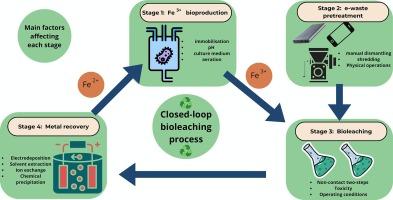从浸出剂生物再生到金属回收的手机闭环生物浸出研究综述
IF 5.9
3区 工程技术
Q1 CHEMISTRY, MULTIDISCIPLINARY
Journal of Industrial and Engineering Chemistry
Pub Date : 2025-04-14
DOI:10.1016/j.jiec.2025.04.020
引用次数: 0
摘要
由于电子废物中含有有毒物质,以及维持制造业所需的金属需求不断增长,电子废物的迅速积累对环境构成了紧迫的挑战。这篇综述探讨了闭环生物浸出作为一种可持续和环保的金属回收解决方案的潜力,重点是报废手机。该过程分为四个相互关联的阶段:(1)浸出剂的生物生产,利用微生物(如氧化亚铁硫杆菌)将Fe2+氧化为Fe3+;(2)电子垃圾预处理,采用机械工艺优化浸出材料;(3)浸出,其中Fe3+从预处理的电子垃圾中溶解有价金属;(4)金属回收,采用溶剂萃取、离子交换和电沉积等方法。本综述研究了影响这些阶段的关键参数,包括培养基组成、pH值、曝气率和电子废物的异质性。与传统的火法冶金和湿法冶金方法相比,生物浸出具有降低能耗和降低环境影响等优点。然而,挑战仍然存在,如改善反应动力学,减轻金属积累的抑制效应,并扩大工业应用的过程。因此,本研究确定了推进闭环生物浸出的关键优先事项:优化生物过程效率,集成自动化和实时监测系统,解决大规模实施的监管和经济障碍。通过对生物浸出过程及其应用的全面分析,本综述强调了其在推动循环经济和促进电子废物可持续增值方面的变革潜力。本文章由计算机程序翻译,如有差异,请以英文原文为准。

Closed-loop bioleaching for mobile phones from the bioregeneration of the leaching agent to the recovery of metal: A review
The rapid accumulation of electronic waste (e-waste) poses a pressing environmental challenge because of the toxic substances it contains, and the growing demand for metals required to sustain manufacturing. This review explores the potential of closed-loop bioleaching as a sustainable and eco-friendly solution for metal recovery, focusing on end-of-life mobile phones. The process is structured into four interconnected stages: (1) bioproduction of the leaching agent, leveraging microorganisms such as Acidithiobacillus ferrooxidans to oxidize Fe2+ to Fe3+; (2) pre-treatment of e-waste, which employs mechanical processes to optimize materials for leaching; (3) leaching, where Fe3+ solubilizes valuable metals from pre-treated e-waste; and (4) metal recovery, using methods such as solvent extraction, ion exchange, and electrodeposition. This review examined the critical parameters that influence these stages, including culture medium composition, pH, aeration rates, and the heterogeneous nature of e-waste. Compared to traditional pyrometallurgical and hydrometallurgical approaches, bioleaching offers advantages such as reduced energy consumption and a lower environmental impact. However, challenges remain such as improving the reaction kinetics, mitigating the inhibitory effects of metal accumulation, and scaling up the process for industrial applications. Therefore, this study identifies the key priorities for advancing closed-loop bioleaching: optimizing bioprocess efficiency, integrating automation and real-time monitoring systems, and addressing regulatory and economic barriers to large-scale implementation. By providing a comprehensive analysis of the bioleaching process and its applications, this review highlights its transformative potential in driving a circular economy and fostering the sustainable valorization of e-waste.
求助全文
通过发布文献求助,成功后即可免费获取论文全文。
去求助
来源期刊
CiteScore
10.40
自引率
6.60%
发文量
639
审稿时长
29 days
期刊介绍:
Journal of Industrial and Engineering Chemistry is published monthly in English by the Korean Society of Industrial and Engineering Chemistry. JIEC brings together multidisciplinary interests in one journal and is to disseminate information on all aspects of research and development in industrial and engineering chemistry. Contributions in the form of research articles, short communications, notes and reviews are considered for publication. The editors welcome original contributions that have not been and are not to be published elsewhere. Instruction to authors and a manuscript submissions form are printed at the end of each issue. Bulk reprints of individual articles can be ordered. This publication is partially supported by Korea Research Foundation and the Korean Federation of Science and Technology Societies.

 求助内容:
求助内容: 应助结果提醒方式:
应助结果提醒方式:


